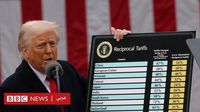The United States has implemented its largest-ever increase in tariffs on Chinese goods, affecting nearly all products imported from China. This significant move raises the total tariffs to at least 54%, a decision that could have devastating consequences for Chinese exports to the world's largest economy.
President Donald Trump announced the new tariffs of 34% on April 2, 2025, during a press conference at the White House. This new levy is in addition to the existing 20% tariffs that took effect earlier this year, impacting approximately $525 billion worth of goods exported by Chinese companies to the U.S. in 2024. Trump stated that the new tariffs will come into effect on April 9, coinciding with the deadline for the White House budget.
Economic analysts have expressed concern over the implications of these tariffs. The Macroeconomic Policy group predicts that China's nominal domestic output could decline by about two-tenths of a percentage point if tariffs reach 60%. According to UBS, such tariffs could halve China's economic growth. Bloomberg Economics has also indicated that trade between the U.S. and China could shrink to nearly nothing if tariffs reach these elevated levels.
In light of these developments, China may be compelled to inject more stimulus into its domestic economy to counteract the anticipated drop in demand due to the tariffs. The nation is already grappling with an oversupply situation that has led to falling prices. Economists expect that the Chinese Central Bank may lower the reserve requirements for banks in this quarter, enabling them to extend more credit to households and businesses.
Despite these challenges, there are signs of resilience in Chinese consumption data, buoyed by government initiatives aimed at stimulating purchases of cars and home appliances. However, consumer inflation has dropped more than expected earlier this year, and manufacturing sector outlooks have declined for the second consecutive month in March, reaching their lowest point in 2025.
In a broader context, Trump's tariff strategy is not limited to China. The president has extended his economic vision to impose tariffs on a range of countries worldwide, starting with Canada, Mexico, and China, and potentially affecting over 200 nations and territories. In a recent address titled "Restoring America's Strength," Trump described the day of the announcement as a "day of liberation" for American trade.
The tariffs imposed on various countries vary, with the lowest set at 10% for imports from the UK and most Arab nations. Countries with significant economic ties to the U.S., such as Colombia and Vietnam, face even higher tariffs, with rates of 49% and 46% respectively, surpassing the 34% imposed on Chinese goods.
Trump's administration has framed these tariffs as a necessary response to what they describe as unfair trade practices, aiming to restore balance in U.S. trade relationships. The administration has expressed hope that these measures will lead to a renaissance in American manufacturing and halt the exploitation of the U.S. economy by foreign nations.
However, analysts warn that this approach could ignite a comprehensive global trade war, with repercussions not only for the U.S. economy but also for its trading partners. Kane Ruoff, a former senior economist at the International Monetary Fund, remarked that Trump's tariffs could lead the U.S. into a recession, with the probability of such an outcome increasing to 50% in light of these developments.
The tariffs have also raised concerns among American manufacturers and consumers. The German Automobile Industry Association (VDA) has condemned the tariffs, stating that they will result in significant losses not only for Germany but also for American consumers and the U.S. automobile industry. The association has called on the European Union to respond decisively, emphasizing that the impact of these tariffs will extend beyond borders.
In addition to the automotive sector, various industries are bracing for the fallout from these tariffs. The U.S. is the largest importer of aluminum and steel globally, and the imposition of tariffs on these materials is expected to increase production costs for American manufacturers, leading to higher prices for consumers.
Moreover, the agricultural sector is also feeling the heat. Mexican farmers are concerned that the 25% tariffs on imports will severely impact their livestock industry, particularly smaller producers who have invested years into building their businesses.
As countries respond to the U.S. tariffs, the global trade landscape is rapidly shifting. China has already announced retaliatory measures, imposing tariffs on U.S. imports of natural gas, coal, and agricultural products. The European Union is also preparing to counteract the tariffs with its own measures, including potential tariffs on American products.
The ramifications of these tariffs are far-reaching, affecting not only the economies of the involved countries but also global supply chains and trade relationships. As nations navigate this complex landscape, the potential for a trade war looms large, with analysts warning of the dangers of escalating tariffs and counter-tariffs.
In conclusion, the recent increase in U.S. tariffs marks a significant turning point in global trade relations, with profound implications for economies worldwide. As countries grapple with the consequences of these policies, the future of international trade hangs in the balance, raising questions about the potential for cooperation or conflict in the coming years.




